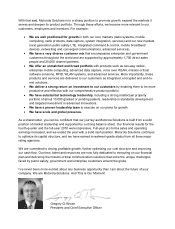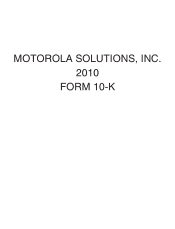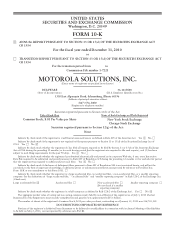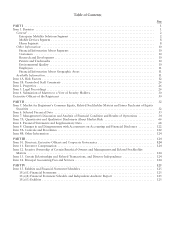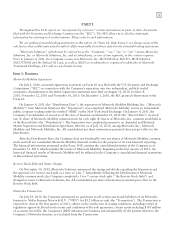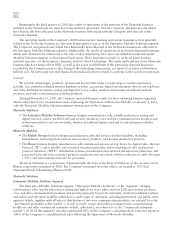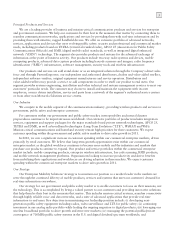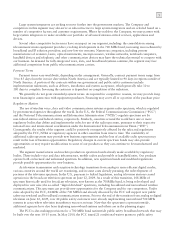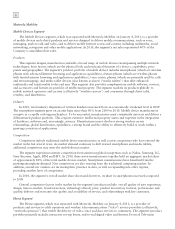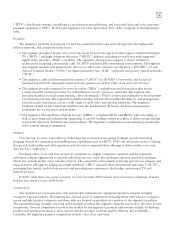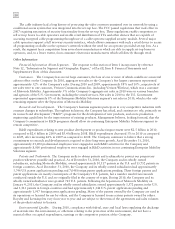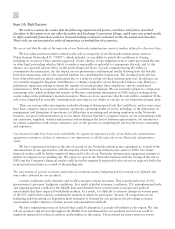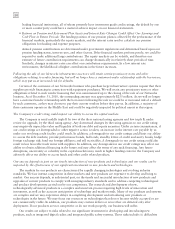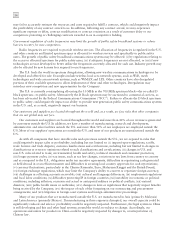Motorola 2010 Annual Report Download - page 14
Download and view the complete annual report
Please find page 14 of the 2010 Motorola annual report below. You can navigate through the pages in the report by either clicking on the pages listed below, or by using the keyword search tool below to find specific information within the annual report.
6
agencies around the country to deploy 700 MHz broadband systems. Over 25 additional waiver petitions are
pending FCC decisions as of December 2010. Several of the broadband waiver grantees also benefit from federal
Broadband Technology Opportunity Policy (“BTOP”) Grant Funds issued by the NTIA during 2010. In 2010, the
segment was awarded a $50.6 million BTOP grant to deploy a broadband system in the greater San Francisco Bay
area. The segment is also working with a number of customers in other areas who received FCC conditional waivers
to use the 700 MHz broadband spectrum. Public safety organizations and the FCC have endorsed the use of Long
Term Evolution (LTE) technology, a technology in which the Company is investing, for this broadband network.
Legislation was also introduced in Congress in 2010 to allocate additional broadband spectrum to public safety in
the 700 MHz band. The legislation must be introduced in the new 2011 Congress. If successful, the legislation
would double the broadband MHz spectrum dedicated for public safety.
In addition to these specific actions during 2010 regarding public safety systems, in March 2010, the FCC
released its overall National Broadband Plan. The plan’s focus is to promote and enable the build-out and
utilization of high-speed broadband infrastructure to benefit a number of key areas, including educational
institutions, healthcare facilities, the energy segment, consumers and others. The Department of Energy also issued a
request for information regarding Smart Grid communications requirements and additional actions regarding the
Smart Grid are expected in the coming year. In April 2010, Canada released rules for public safety use of the
700MHz narrowband spectrum. In November 2010, Canada also released a consultation requesting input on
making broadband spectrum available for public safety use in the 700 MHz band. Decisions regarding broadband
use in Canada are expected to be released during 2011. Canada has established August 31, 2011 as the date for
clearing television operations from 700 MHz spectrum, which should also help open opportunities for mobile
systems to deploy in the band. Internationally, the ITU World Radio Conference held in Geneva in November 2007
identified spectrum that could be made available as part of a “digital dividend” as television transitions from analog
to digital technology globally. Countries around the world are studying the potential size, timing and use of this
potentially available spectrum.
Some of our operations use substances regulated under various federal, state, local and international laws
governing the environment and worker health and safety, including those governing the discharge of pollutants into
the ground, air and water, the management and disposal of hazardous substances and wastes and the cleanup of
contaminated sites. Certain of our products are subject to various federal, state, local and international laws
governing chemical substances in electronic products.
Backlog
The segment’s backlog position as of the end of the last two fiscal years was approximately as follows:
December 31, 2010 $2.6 billion
December 31, 2009 $2.6 billion
The 2010 order backlog is up slightly and believed to be generally firm. Approximately 77% of that amount is
expected to be recognized as revenue during 2011. The forward-looking estimate of the firmness of such orders is
subject to future events that may cause the amount recognized to change.
Intellectual Property Matters
Patent protection is extremely important to the segment’s operations. The segment has an extensive U.S. and
international portfolio of patents relating to its products, systems, technologies and manufacturing processes,
including recent research developments in scanning, information collection, mission critical two-way radio
communication, network communications and network management. We have also filed additional patent
applications in the U.S. Patent and Trademark Office, as well as in foreign patent offices.
The segment licenses some of its patents to third parties, but this revenue is not significant. The segment is also
licensed to use certain patents owned by others. Royalty and licensing fees vary from year to year and are subject to
the terms of the agreements and sales volumes of the products subject to licenses.
We actively participate in the development of open standards for interoperable, mission-critical digital two-way
radio systems. We have published our technology and licensed patents to signatories of the industry’s two primary
memorandums of understanding defined by the Telecommunications Industry Association (“TIA”), Project 25,
European Telecommunications Standards Institute (“ETSI”), and TETRA.


